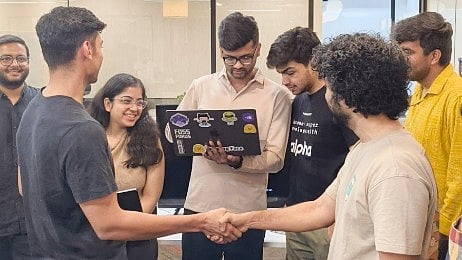
A vibe coding hackathon held in HSR Layout last month saw the participation of over 30 people.
Source: NimishaChanda/X
Vibe coding — or programming with the help of artificial intelligence (AI) — is catching on in Bengaluru, with non-tech professionals building custom websites and apps in just a few hours or days.
Instead of writing code from scratch, they use plain-English prompts like ‘Make me XYZ with ABC features’ on platforms such as Cursor, Replit, Windsurf, Bolt, and Lovable to get the job done.
While these platforms are free to use, many are paying an average of $20 (Rs 1,700 approximately) per month to unlock advanced features, saying “it’s worth it”.
Level-playing field
Take Atharva Kharbade, a growth marketer who went viral in March for building staybroke.in — a database of ultra-luxury goods — in just two days. A college dropout, he feels vibe coding has provided non-techies like him a level-playing field in the competitive job market. His new skill landed him a job last week at a vibe coding platform.
Kharbade also took part in a vibe coding hackathon in HSR Layout on March 29, where 16 non-techies teamed up with IT professionals with 1–5 years of experience. The winning duo built a fan fiction generator that illustrated stories in various art styles. Other ideas included chatbots to diagnose health symptoms, flag bad push-up posture, write novels from a one-line brief, find underrated films, and create Instagram reels starring one’s AI clone. One team developed a productivity app that fines users for wasting time online and donates the amount to charity.
Self-learning
The hackathon was hosted by Nimisha Chanda and Vedant Rawal, both from non-tech backgrounds. Nimisha, a marketing professional, began exploring AI programming assistants last November — before computer scientist Andrej Karpathy coined the term vibe coding in February. “I was curious — and wanted to stay ahead of my peers,” she says.
She taught herself “the basics of tools like Replit, Python, and VS Code via YouTube before prompting AI tools”.
Her first product was a “personalised GPT to ideate and execute marketing strategies”, which she uses at work with her employer’s support. Since then, she’s created a fintech chatbot to explain tax forms and run investment calculations.
Her advice: “Be specific in your prompts — from the colour scheme to layout — or you’ll waste time circling back to fix errors.”
Finance professional Naga Subramanya agrees and says, “Vibe coding tools are great for frontend design, but not as intuitive for debugging when something malfunctions or behaves unexpectedly.”
He’s building a loan repayment calculator to replace clunky Excel sheets his team uses. He has spent about four hours on it so far and taken help from his office tech team to fix backend issues. “They’ve advised me to implement security and confidentiality protocols since the tool will be used at work,” he adds.
Others are testing business ideas. Serial entrepreneur Prasad R is developing an education platform for children, with features to auto-generate personalised colouring worksheets. “I studied computer engineering but never enjoyed coding. Now I can prototype quickly, discard what doesn’t work, and reiterate. If my business idea takes off, I’ll hire a professional team,” he says.
Integration in companies
Vibe coding is no longer just a tool for individual hobbyists — it is increasingly becoming part of the workflow in large companies, aimed at boosting productivity and shortening turnaround times. Tasks that once required months and coordination across multiple teams can now be completed in just 6 to 8 hours, allowing for quicker development of working prototypes and faster feedback from stakeholders and clients, says Chandramouli Coorg Subramaniam, senior vice president of artificial intelligence at a global organisational consulting firm.
Two teams under his leadership have moved from using Copilot last year to more advanced tools like Cursor. According to him, today’s AI coding assistants can generate 70 to 80 percent of the required output. However, debugging remains a significant challenge. Since these tools are trained on open-source code from across the Internet, the results can often be inconsistent or overly generic, which makes troubleshooting more difficult.
Subramaniam notes that when hobbyists encounter such roadblocks, there's often a tendency to scrap the entire project and start over. To mitigate this, he recommends a few key practices: saving work regularly to allow easy rollbacks, maintaining an internal library of coding styles tailored to individual or company-specific standards to ensure better alignment with project requirements, and most importantly, applying first-principles thinking to clearly define the use case and expected outcomes.
Subramaniam cautions that these AI assistants are not yet suited for developing production-grade software. He also draws attention to the concerns around security and intellectual property that accompany vibe-coded projects.